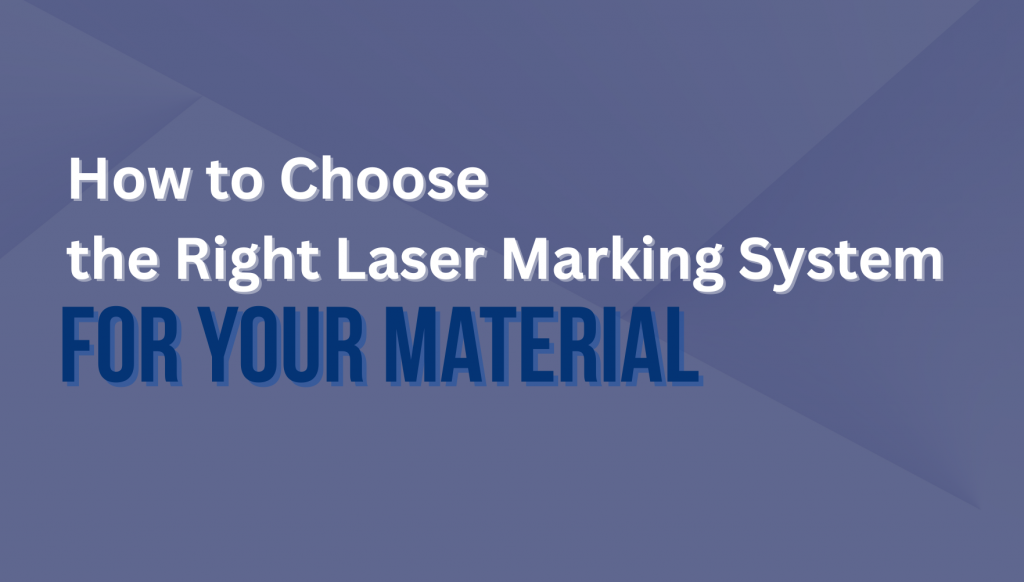| Oct 23, 2025
How to Choose the Right Laser Marking System for Your Material

Selecting the right laser for part marking isn’t just about getting in on the latest technology, it’s also crucial to match the right laser type to your material. Metals, plastics, ceramics, and organics all respond differently to laser wavelengths, so picking the wrong laser can lead to poor markings or even compliance risks.
Your material should be the first thing to consider when choosing a laser, then you can narrow it down to the best-fit marking system for your application.
At MECCO, we provide a full range of laser marking solutions, including fiber, variable-pulsed (VP) MOPA, CO2, and UV lasers. Below, we break down how each of these technologies works, the materials they’re best suited for, and the applications where they excel.
Why Laser Choice Matters
The laser marking system you choose can have a critical impact on the quality and outcome of the finished product. Factors like material type, level of detail needed, heat sensitivity, and how the laser integrates into your production line all play a role.
Choosing the wrong laser could result in poor mark quality or a slowdown in production. By contrast, the right laser gives you better performance, consistent results, and production efficiency – matched to the exact material you’re working with.
Let’s examine each type of laser system in more detail and review the materials they work best with.
Fiber and VP MOPA Lasers
Fiber lasers generate a one-micron wavelength within a solid fiber optic cable and are the preferred choice for marking metals and select plastics. They are long-lasting, energy efficient, and require minimal maintenance.
VP MOPA is a type of fiber laser that offers greater versatility with adjustable pulse duration, enabling finer control over contrast and depth.
Materials and Applications:
- Steel
- Titanium
- Aluminum
- Copper
- Ceramic
- Acrylic
- ABS + PC
- PA6
- PEEK
Fiber and VP MOPA can be used on almost any laser application, including marking, ablation, and bonding. VP MOPA is especially effective for:
- High-contrast plastic marks
- Deep engraving on metals
- Black marks on clear anodized aluminum
Industries Using Fiber and VP MOPA Lasers:
VP MOPA and fiber lasers are commonly used in industries where high-speed, high-clarity marking is critical, including:
- Automotive manufacturing
- Aerospace and defense
- Medical device manufacturing
- Electronics and semiconductor
- Energy, oil & gas, and heavy industry
- Industrial tooling and equipment manufacturing
MECCO Systems Using VP MOPA:
CO2 Lasers
CO2 lasers use an electrically stimulated gas mixture (primarily carbon dioxide, nitrogen, and helium) within a sealed tube to produce a beam with a wavelength of 10600 nanometers. This wavelength is ideal for organic, non-metal materials.
Materials and Applications:
- Wood
- Cardboard
- Leather
- Cork
- Foam
- Acrylic
- Glass
Common Uses:
- Date codes
- Serial numbers
- Product IDs for packaging and consumer goods
Industries Using CO2 Lasers:
Industries where organic substrates dominate typically use CO2 lasers, such as:
- Packaging and consumer goods
- Woodworking and furniture manufacturing
- Electronics and electrical equipment
- Medical device packaging and plastics
- Automotive interiors and components
- Plastics and rubber manufacturing
MECCO Systems Using CO2 Laser
- SMARTmark OEM
- LightWriter PRO Connect
- Custom and Configured CO2 Systems
UV Lasers (Cold Marking)
UV lasers operate at a 355-nanometer wavelength and use a “cold marking” process, achieved through short pulse durations that reduce heat input. This makes UV lasers ideal for delicate or heat-sensitive materials.
Materials and Applications:
- Glass
- Soft plastics
- Ceramic
- Thin metals
UV lasers are best for applications where clarity and minimal damage are critical, including:
- Carbon migration
- Laser annealing
- Laser cutting
- Laser discoloration
- Laser etching and engraving
Industries Using UV Lasers:
Industries that require high-precision, damage-free marks on delicate or heat-sensitive materials typically use UV lasers, such as:
- Medical device manufacturing
- Electronics and semiconductor
- Automotive components (interior plastics)
- Consumer electronics and mobile devices
- Aerospace (lightweight composites and sensitive components)
- Pharmaceutical and packaging
- Precision instrumentation and optics
- Watchmaking and luxury goods
MECCO Systems Using UV Lasers:
- SMARTmark OEM
- LightWriter PRO Connect
- Custom and Configured UV Laser Systems
Laser Selection Quick Guide
Below is a “quick guide” outlining the best materials for each type of laser.
| Laser Type | Best for | Materials | MECCO Products |
| Fiber/VP MOPA | Metal marking, plastic welding, engraving | Steel, aluminum, titanium, copper, ceramics, some plastics | SMARTmark OEMLightWriterLightWriter PRO ConnectCustom and Configured |
| CO2 | Organic materials, date coding, packaging | Wood, glass, leather, cardboard, acrylic, cork, foam | SMARTmark OEMLightWriter PRO ConnectCustom and Configured |
| UV | Carbon migration, laser annealing, laser cutting, laser discoloration, etching and engraving, laser marking | Plastics, glass, ceramics, silicon, thin films | SMARTmark OEMLightWriter PRO ConnectCustom and Configured |
When it comes to part marking, the material is your starting point. With over 135 years of expertise, MECCO is a trusted industrial partner providing a full range of fiber, VP MOPA, CO2 and UV lasers for part identification and traceability. Our US-based team of experts is ready to help you choose the right laser to ensure the best quality markings with unmatched production efficiency.
Contact MECCO today with any questions or help selecting the laser marking system that’s right for you.
